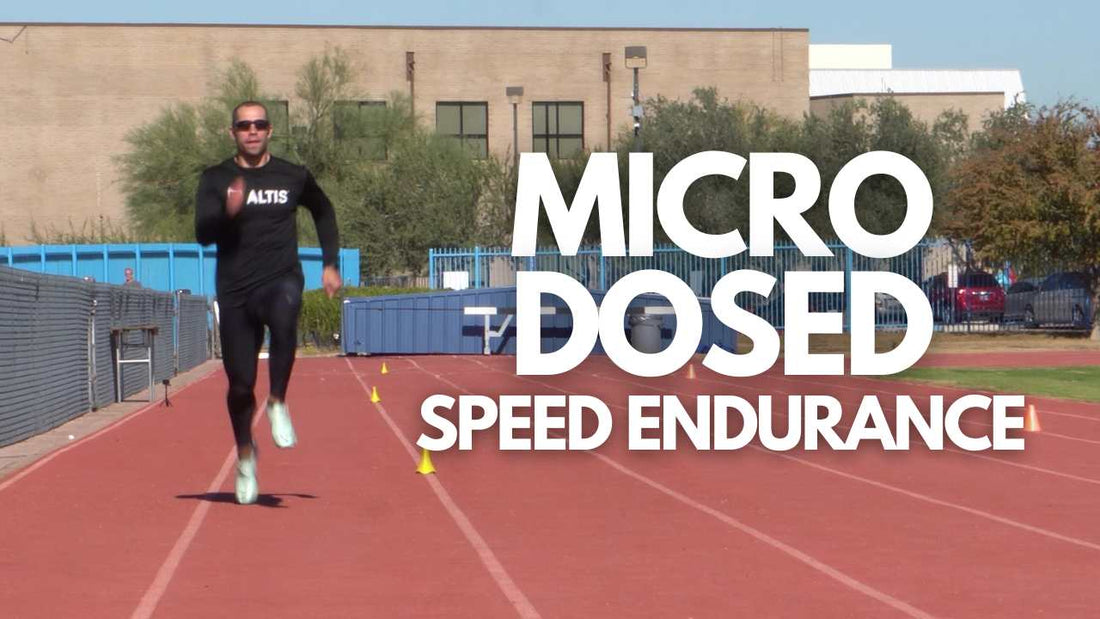Speed endurance training is vital for sprinters who want to run fast in any sprint event, especially the 100m, 200m, and 400m dash.
While necessary, it can sometimes be a challenge to decide how much speed endurance (SE) a sprinter should do, when it
should be implemented in the program, and how best to progress from shorter sprints into longer speed endurance reps.
This article will go over the concept of micro-dosing speed endurance training, why it is beneficial, and how you can implement this approach into your sprint training program.
What This Article Covers:
- What Is Micro-Dosing For Speed Endurance?
- What Are The Benefits Of Micro-Dosing Speed Endurance?
- How Can You Implement Micro-Dosed Speed Endurance Training?
What Is Micro-dosing As It Relates To Speed Endurance Training?
In sprinting, micro-dosing is the concept of including a particular type of training in your program but doing so with a very low volume of that specific type of work.
While I am sure other coaches have done this before, I came up with this idea in my own training as I struggled to decide how and when to introduce speed endurance sessions into my off-season training program.
Suppose you go from only doing acceleration and speed training to adding a session dedicated to speed endurance training. In that case, the athlete may need more preparation for that workload, leading to excessive soreness, fatigue, a low-quality workout, and a higher risk of injury.

If the athlete were only doing shorter sprints up until the point speed endurance was instituted, it would be a shock to their system to run multiple sprints at a much longer distance than they are used to.
To solve that, I decided to add one or two sprints into acceleration and speed training sessions.
This helps achieve the following:
- Micro-dosing familiarizes the athlete with speed endurance training.
- Micro-dosing progresses the training stimulus with a longer sprint.
- Micro-dosing minimizes the risk of injury, soreness, and fatigue by starting with a single repetition of speed endurance.
In using this micro-dosed speed endurance approach, I improved my 150-meter personal best at age 31 from 16.32 to 15.94, an improvement of over two percent!
Why Is Micro-dosing Speed Endurance Beneficial For Sprinters?
This micro-dosing approach has several benefits when progressing toward speed endurance training during your off-season.
First, micro-dosing helps you introduce more intense forms of sprint training without causing a shock to the athlete. As coaches, it is important that we gradually progress the athlete's training, as this helps avoid soreness, preventing downtime and missed sessions that occur when the athlete is too beat up from their training.
Second, micro-dosing allows the athlete to begin working on speed endurance earlier in the year. Most athletes can run a fast 120m or 150m sprint during the winter, whereas they may not be able to run three or four of these sprints in a workout.
Third, micro-dosing gives you more ways to progress training over time. You could start by adding in a single 70m, 90, or 110m sprint at the end of the training session and progress the distance of this sprint. Alternatively, you could increase the number of speed endurance reps added to the end of the workout, shifting toward a speed endurance focused session once the athlete has been doing a couple of SE reps during their speed or acceleration sessions.
Essentially, micro-dosed speed endurance allows you to introduce speed endurance earlier in the training year, while ensuring you do not neglect the speed and acceleration training sessions the athlete needs to be doing during this time of year.
How Can You Implement Micro-dosed Speed Endurance Training?
Micro-dosed speed endurance training should be implemented into your sprint training program once the athlete has done acceleration and speed training for a couple of months.
First, we develop acceleration abilities and limit the athlete's velocity in practice by limiting the distance sprinted. A 10-meter sprint at 100% effort will exhibit lower velocities than a 50-meter sprint run at that same intensity.
Once the ability to accelerate is developed, we increase the velocity of sprints by adding speed training, which tends to be trained with sprints between 30 and 60 meters in length.
After the athlete has been doing speed training for a few weeks, they should be able to start micro-dosing short-speed endurance, with sprints ranging from 70 to 120 meters in length. This can then be progressed up to 150m if the athlete is in good shape or 180m for 200m/400m type athletes.
Micro-dosed speed endurance runs can be done as a standalone session. Still, I prefer to utilize this approach during other training sessions, tacking a longer sprint at the end of an acceleration training session. You can do this with speed training sessions as well, but the intensity of these sessions are higher, and fatigue must be managed accordingly.
Example Session With Micro-dosed Speed Endurance:
- Track Warmup
- 5-6x30m Block Starts above 95% intensity.
- 1x120m to 150m above 95% intensity.
To be certain that you are keeping training volumes appropriate when micro-dosing speed endurance, you can use timing gates to measure the athletes sprint times. If you see times drop significantly, that is a good time to end the workout.
